For many U.S. manufacturers, end-of-line packaging is where time and costs quietly add up. A poorly wrapped pallet can lead to damaged products, unstable loads, and higher shipping claims, problems that directly impact margins and customer trust.
In 2025, pallet wrapping machines have become more advanced, efficient, and reliable. From semi-automatic turntable models to fully automated conveyorized systems, manufacturers now have equipment that delivers consistent wraps, uses less film, and integrates seamlessly with production lines.
This guide will break down the best pallet wrapping machines for manufacturing plants in 2025, how to evaluate them, specifications, and which models make sense under various plant conditions.
Key Takeaways:
- A good pallet wrapping machine keeps products stable during transport, reduces damage, and improves safety across the supply chain.
- Small facilities benefit from semi-automatic models, while high-volume plants gain more from fully automatic or conveyorized systems that run continuously.
- Machines with powered pre-stretch can cut film waste by up to 40%, saving money and supporting sustainability goals.
- Modern wrappers now use sensors, data monitoring, and energy-efficient systems to deliver consistent wraps and reduce long-term operating costs.
What Is Pallet Wrapping (or Stretch Wrapping)?
Pallet wrapping, often referred to as stretch wrapping, is the process of tightly securing a load on a pallet using a stretchable plastic film. This film, typically made of linear low-density polyethylene (LLDPE), stretches and clings to itself, creating tension that stabilizes and protects products during storage and transit.
At its simplest, the process involves:
- Applying stretch film around the pallet load (manually or via machine).
- Tensioning the film to achieve secure containment.
- Sealing or cutting the film automatically at the end of the cycle.
Unlike shrink wrap, which relies on heat to conform to the product’s shape, stretch film works purely through mechanical tension, making it faster, more cost-efficient, and ideal for heavy or irregular loads commonly found in manufacturing, logistics, and industrial distribution.
Why Pallet Wrapping Matters in Manufacturing?
Every pallet leaving a U.S. plant represents not just finished goods but potential profit or loss. The cost of product damage during transit, load collapse, or film waste can quickly accumulate. That’s why choosing the right wrapping technology is a strategic decision for 2025 manufacturers.
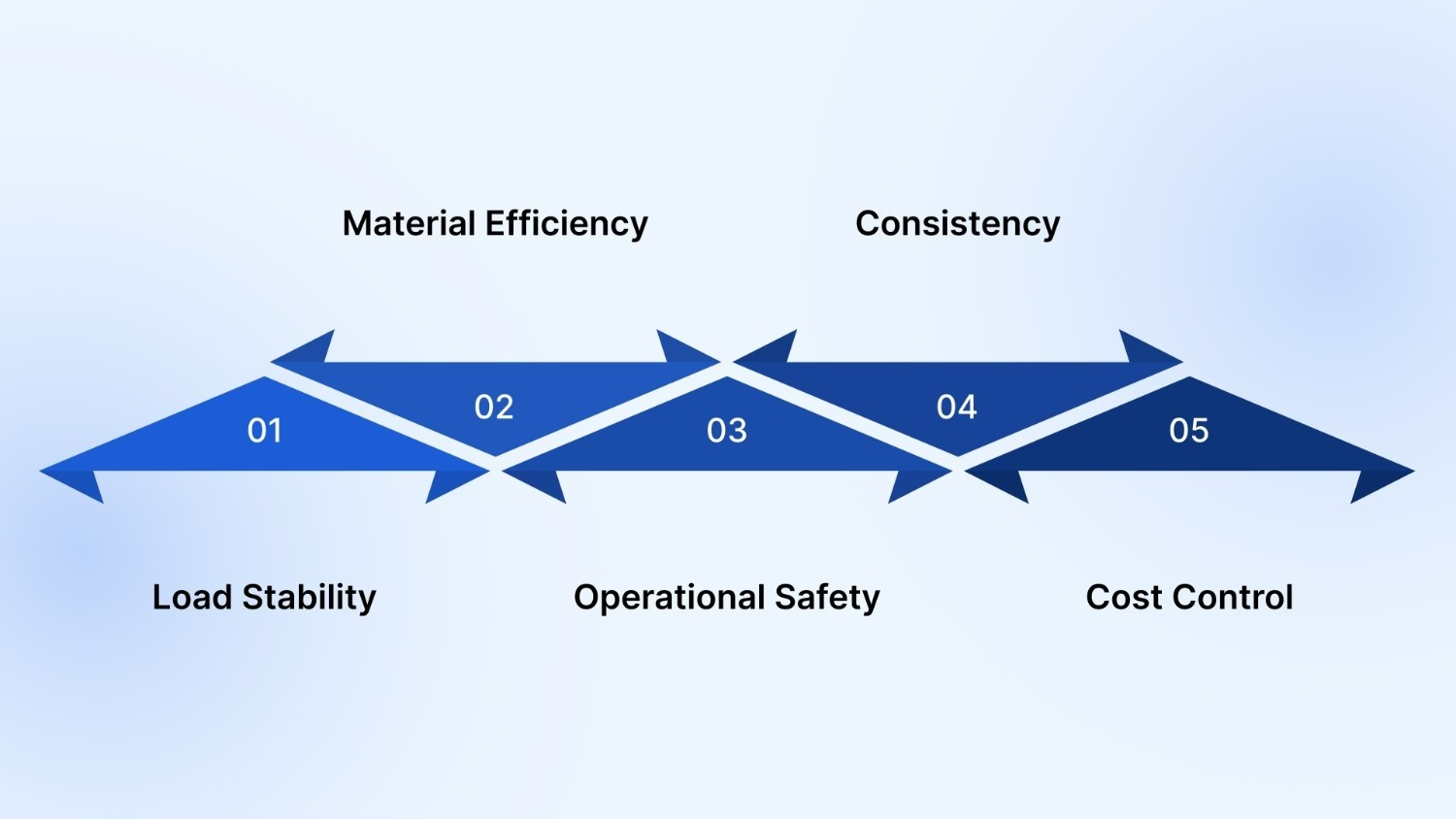
Key benefits include:
- Load Stability: Prevents load shifting and reduces product damage in transport.
- Material Efficiency: Advanced machines can pre-stretch film up to 260%, cutting plastic use by up to 30%.
- Operational Safety: Reduces manual strain and repetitive motion injuries from hand-wrapping.
- Consistency: Automated tensioning ensures every pallet is wrapped with a uniform containment force.
- Cost Control: Lowers labor costs and film expenditure per pallet.
Core Technical Terms You Should Know
When evaluating pallet wrapping machines, you’ll encounter a few technical metrics. Here’s what they mean in practical terms:
For a full breakdown of film gauge and containment optimization, see John Maye’s Plastic Wrap Gauge and Thickness Guide, which explains how gauge selection influences both performance and cost.
Don’t Confuse Stretch Wrapping with Shrink Wrapping
While both are used to secure products, their mechanisms and purposes differ:
Understanding this difference ensures you choose a system aligned with your production needs, not just the cheapest available option.
Suggested Read: What is Shrink Wrap: A Complete Guide
Types of Pallet Wrapping Machines
Choosing the right pallet wrapping machine depends on your production scale, floor space, load characteristics, and automation goals. Below is a breakdown of the major types of wrapping machines and their ideal use cases.

1. Manual and Semi-Automatic Turntable Wrappers
Manual and semi-automatic turntable wrappers are the entry point for most manufacturers transitioning from hand-wrapping. They use a rotating base (turntable) to spin the pallet while the operator controls the film carriage, either manually or via automatic preset settings.
Best For
- Low to medium production volumes (10–30 pallets per hour)
- Plants looking to reduce film waste and operator fatigue
- Facilities with limited automation budgets
Advantages
- Affordable and compact footprint
- Consistent film tension compared to manual wrapping
- Easy to operate and maintain
- Compatible with various film gauges and load sizes
Example Model
FLEX RTD Rotary Tower Semi-Automatic Wrapper
- Type: Rotary tower semi-automatic
- Best for: Mid-volume manufacturers and irregular loads
- Key Features: Consistent film pre-stretch control, adjustable wrap tension, intuitive digital controls, and safety interlocks for operator protection
2. Fully Automatic Turntable Wrappers
Fully automatic systems perform the entire wrap cycle without operator involvement.
These machines integrate with conveyor lines and include automatic film clamping, cutting, and sealing mechanisms, making them ideal for high-volume packaging plants.
Best For
- Continuous operation with 50+ pallets per hour
- Facilities requiring integration with palletizing or conveyor systems
- Manufacturers aiming for labor-free end-of-line automation
Advantages
- Increased throughput and consistency
- Reduced operator dependency
- Excellent ROI in large-scale facilities
- Seamless integration with ERP and conveyor automation systems
Example Model
4100-35FA-FS3 Fully Automatic Pallet Wrapper
- Automation: Fully automatic, PLC-controlled system
- Features: Programmable wrap patterns, film break detection, automatic film clamp & cut, heavy-duty steel frame.
- Ideal For: 24/7 industrial packaging operations where uptime and repeatability are critical
3. Rotary Arm (Straddle) Wrappers
In rotary arm (or straddle) wrapping systems, the pallet remains stationary while the wrapping arm rotates around it. This design is perfect for unstable, lightweight, or oversized loads that shouldn’t be spun on a turntable.
Best For
- Fragile or irregular loads (beverages, glass, unstable stacks)
- High-throughput manufacturing and distribution centers
- Loads exceeding standard turntable weight limits
Advantages
- Reduces the risk of load collapse or shifting
- Handles variable pallet heights and sizes
- Ideal for inline conveyor operations
- Enables continuous wrapping without pause
Example Model
- Speed: Up to 30 RPM rotation
- Pre-Stretch Capability: 250%+
- Controls: Touchscreen interface with pre-programmed film profiles
- Benefit: Designed for heavy-duty, continuous-use industrial lines
4. Ring and Orbital Wrappers
Ring (or orbital) wrappers use a circular ring through which the pallet passes horizontally or vertically. They’re engineered for long, irregular, or horizontal products, such as lumber, doors, pipes, and textiles.
Best For
- Non-standard load shapes
- Long or flat products that can’t rotate
- Automated conveyor-driven lines
Advantages
- Customizable for horizontal or vertical wrapping
- Consistent containment across irregular geometries
- Efficient material usage with programmable film overlap
Common Use Cases
- Construction materials, automotive parts, and furniture manufacturing
- Distribution centers handling mixed product profiles
5. Hybrid and Custom Engineered Systems
Some plants need more than a “one-size-fits-all” approach. Custom-engineered and hybrid wrapping systems are tailored to your workflow, combining elements of turntable, rotary arm, and robotic operation.
These systems integrate directly with your existing conveyors, case sealers, or palletizing robots to ensure seamless packaging automation.
Advantages
- Configurable for unique load types and plant layouts
- Can integrate with robotic palletizers or AGVs
- Engineered for high-speed, low-downtime operations
By partnering with a trusted distributor like John Maye Company, U.S. manufacturers gain access to a full range of proven pallet wrapping systems, local support, and expert integration guidance, ensuring your packaging line runs reliably, efficiently, and cost-effectively.
How to Choose the Right Pallet Wrapping Machine for 2025?
U.S. manufacturers in 2025 face a unique mix of challenges: higher labor costs, supply chain fluctuations, and the growing need for sustainability. The right system can help balance all three.
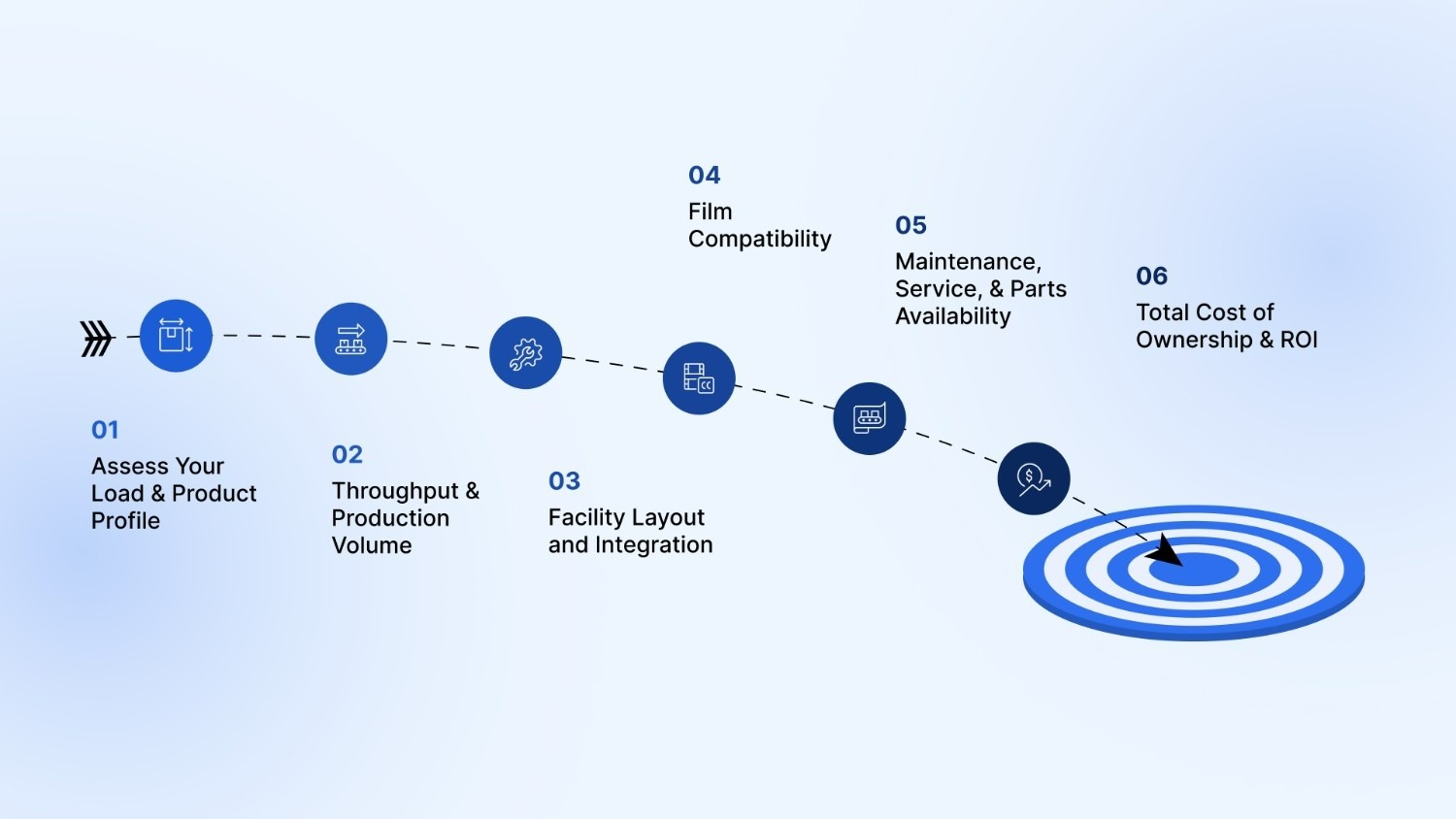
Below is a practical guide to help manufacturing decision-makers identify the best fit for their specific operation.
1. Assess Your Load and Product Profile
Every good packaging line starts with understanding the load itself. Ask: What are we wrapping, how stable is it, and how uniform are our loads?
- Weight and Height: Heavy loads (>4,000 lbs) or tall pallets (>80”) typically perform better on rotary arm or ring-style machines.
- Stability: Irregular or uneven loads may need stationary wrappers to avoid tipping.
- Surface Characteristics: Sharp edges or protrusions require tougher films and careful containment settings.
- Product Sensitivity: For fragile items like food or electronics, consistent tension and gentle film application are essential.
A simple containment-force test (using film force gauges) can reveal if your current setup over- or under-wraps your pallets, both of which add hidden costs.
2. Throughput and Production Volume
Your required pallets per hour (PPH) output should be the leading metric in your equipment selection.
Tip: Many plants overestimate throughput needs; running a true-time study helps prevent overbuying a machine that will run under capacity.
3. Facility Layout and Integration
Space constraints often dictate your choice more than budget. When selecting a pallet wrapper, consider how it fits within your end-of-line layout and whether it can integrate with existing conveyors or case sealers.
- Turntable Machines: Require smaller floor space and are ideal for standalone operations.
- Rotary Arm / Straddle Systems: Need more clearance, but excel for inline conveyors and tall loads.
- Ring or Orbital Systems: Best integrated into high-speed packaging lines where pallets move automatically.
4. Film Compatibility and Cost Control
Film costs account for a major portion of packaging expenses. Advanced machines can optimize this dramatically through film pre-stretch systems and force-to-load feedback.
- Powered Pre-Stretch Systems: Most wrappers John Maye distributes feature 260% pre-stretch capability, drastically reducing film consumption.
- Film Threading Design: Systems such as the 6100-45-CTA use “Super Rapid Thread II” film carriages for faster, safer film threading.
- Film Gauge Flexibility: Verify the wrapper supports your preferred film thickness and width for optimal containment and minimal waste.
5. Maintenance, Service, and Parts Availability
Machine downtime directly impacts ROI. Choosing a system supported by U.S.-based service teams and readily available parts is critical.
What to prioritize:
- Service Access: Machines with modular components and tool-free panels are easier to maintain.
- Preventive Maintenance Programs: Regular tune-ups extend equipment lifespan and reduce film jams or tension drift.
- Technician Support: Ensure access to manufacturer-trained technicians for rapid on-site or remote troubleshooting.
John Maye Company stands out as a long-time U.S. distributor offering:
- 24-hour parts shipping for standard systems.
- On-site service and integration support across the Midwest and East Coast.
- Preventive maintenance programs to reduce unplanned downtime.
6. Total Cost of Ownership (TCO) and ROI
Beyond the upfront cost, evaluate the total lifecycle cost:
- Initial Investment – Machine + installation
- Operational Cost – Film, labor, energy consumption
- Maintenance Cost – Parts, downtime
- Product Loss – Damage due to poor containment
A higher-end machine can often pay for itself within 18–24 months through reduced film use and labor savings. John Maye offers rental and leasing options, making it easier for plants to upgrade without major capital expenditure.
Top Pallet Wrapping Machines for Manufacturing Plants in 2025
The U.S. manufacturing sector in 2025 is prioritizing automation, precision, and sustainability. Pallet wrapping systems that deliver higher throughput, film efficiency, and integration flexibility are now essential to maintaining competitive operations.
Below is a curated selection of the best pallet wrapping machines for manufacturing plants in 2025.
Explore John Maye’s Pallet Wrapping Equipment page.
Implementation & Best Practices
Selecting the best pallet wrapping machine for your manufacturing plant is only the first step. To unlock maximum value, you must implement the system effectively, train your operators, and monitor wrap quality continuously.
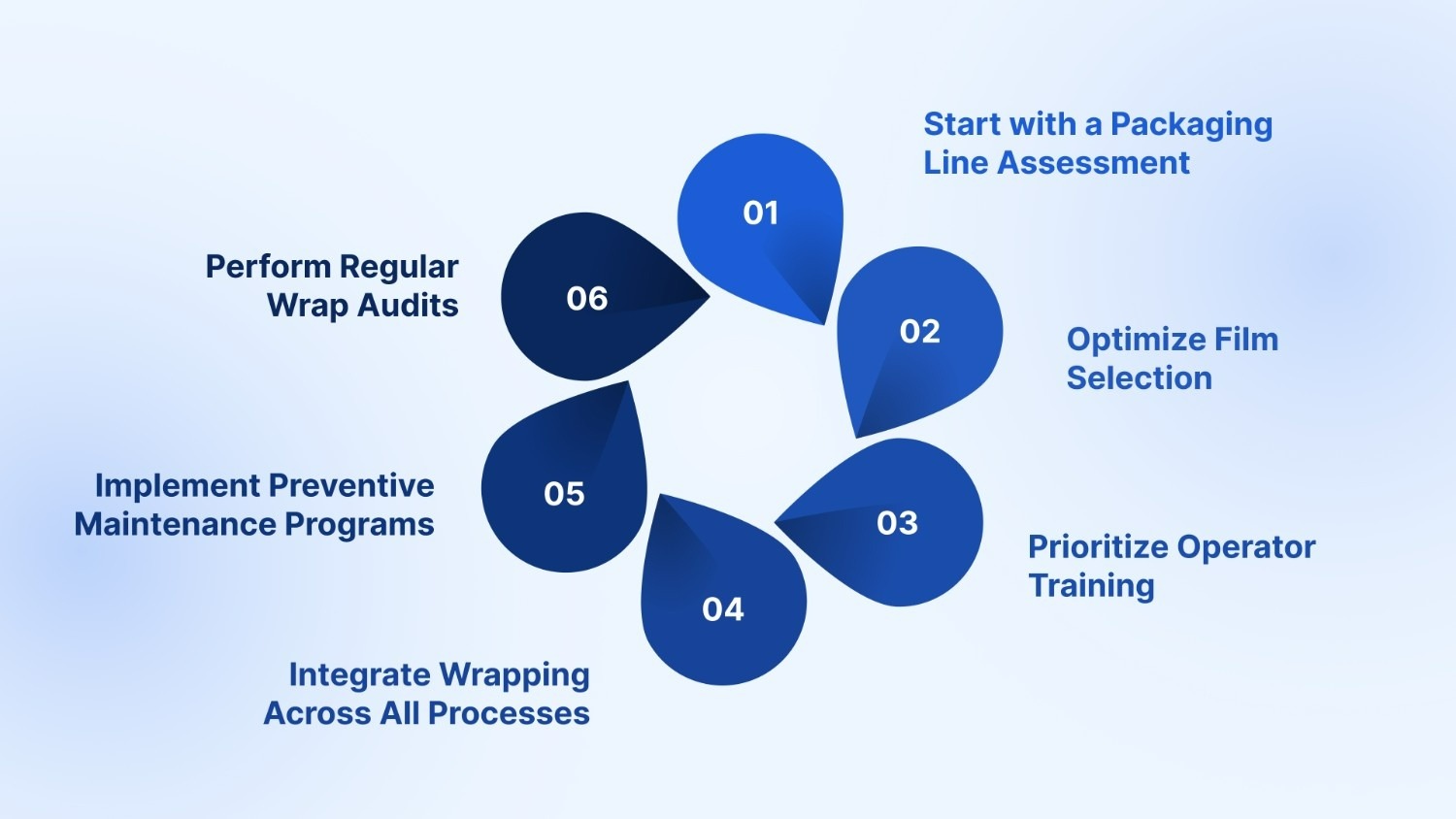
Below are the key steps and best practices to ensure long-term performance, safety, and ROI from your pallet wrapping investment.
1. Start with a Packaging Line Assessment
Before selecting or installing a new wrapper, conduct a detailed end-of-line assessment:
- Map out product flow, including infeed/outfeed conveyor speeds, floor layout, and clearance heights.
- Measure average pallet dimensions, weight range, and film usage.
- Identify where manual processes or inconsistent wrapping slow production.
John Maye Company’s team supports U.S. facilities with on-site evaluations, ensuring the selected machine integrates seamlessly with existing lines.
2. Optimize Film Selection and Containment Settings
Film performance directly impacts cost, containment, and sustainability. Follow these guidelines to maximize value:
- Match film gauge and stretch rating to the machine’s pre-stretch capability.
- Conduct a containment force test for each product category.
- Use consistent wrap patterns and tension profiles across shifts.
3. Prioritize Operator Training and Safety
Even the most advanced automatic system needs skilled operators for setup and maintenance. Proper training ensures safety, optimizes wrap consistency, and reduces downtime caused by incorrect use.
Training essentials:
- Safe machine start-up, shutdown, and emergency procedures.
- Film threading and carriage cleaning.
- Understanding pre-stretch settings and load profiles.
- Routine inspection points (belts, motors, rollers).
- How to identify signs of film wear or tension drift.
4. Integrate Wrapping with Upstream and Downstream Processes
For 2025-ready plants, wrapping is part of a connected packaging ecosystem. Integrating your wrapper with conveyors, case sealers, labelers, and palletizers improves flow, traceability, and operator efficiency.
Integration Tips:
- Synchronize conveyor speed with wrapping cycle to prevent jams.
- Automate pallet discharge to staging or storage zones.
- Use sensors or scanners for barcode or RFID tracking.
- Connect wrapping data to MES/ERP for performance analytics.
5. Implement Preventive Maintenance Programs
Consistent upkeep ensures reliability and extends equipment lifespan. Instead of waiting for breakdowns, adopt a preventive or predictive maintenance schedule.
Maintenance routine checklist:
- Daily: Inspect film carriage rollers, photo-eyes, and film clamps.
- Weekly: Check turntable alignment and chain tension.
- Monthly: Clean sensors, lubricate gears, and test the emergency stop.
- Quarterly: Replace worn belts, update PLC software, and recalibrate tension settings.
John Maye Company offers preventive maintenance contracts that include scheduled inspections, priority parts access, and service reporting, minimizing downtime and maximizing ROI. Explore Equipment Servicing & Maintenance Plans.
6. Perform Regular Wrap Audits
Regular wrap audits ensure consistency and highlight hidden inefficiencies.
- Film tension calibration
- Load containment testing
- Material usage benchmarking
- Operator adherence to SOPs
These audits help identify opportunities for downgauging film, improving pre-stretch ratios, and optimizing throughput without sacrificing load stability.
Implementing your pallet wrapping system effectively ensures long-term reliability, lower costs, and consistent packaging quality.
For expert guidance on selecting and integrating the best pallet wrapping machines for manufacturing plants in 2025, partner with John Maye Company. Contact us today to optimize your packaging line and safeguard your business. Connect here.
Why Partner with John Maye Company?
As U.S. manufacturers continue to balance labor challenges, rising material costs, and sustainability goals, pallet wrapping automation remains one of the most practical ways to improve operational performance.
But choosing the right machine is only half the story. Success depends on expert guidance, proper installation, and ongoing service support.
That’s where John Maye Company stands out. As a trusted packaging equipment distributor and integration partner, John Maye connects manufacturers to industry-leading OEMs like Cousins, Orion, and SOCO, providing:
- Comprehensive Solutions: From case erectors and sealers to shrink wrap systems, conveyors, and pallet wrappers, John Maye provides complete packaging automation equipment and consumables.
- Fast Fulfillment: A large inventory of over 2,500 SKUs allows 24-hour shipping, reducing downtime for fulfillment centers.
- Flexible Access: Businesses can purchase, lease, or rent machines to match budget and demand cycles.
- Expert Service: Factory-trained technicians handle installation, preventive maintenance, and 24-hour emergency repairs.
- Custom Engineering: Tailored system design integrates equipment ergonomically into existing packaging lines for higher efficiency.
Get expert recommendations tailored to your facility’s layout, load profile, and production goals. Contact John Maye Company to schedule a free consultation or request a quote today.
FAQs
1. What are the main types of pallet wrapping machines?
The main types include turntable, rotary arm, and ring or orbital wrappers. Turntable systems spin the load, while rotary and ring types keep the pallet still for unstable items.
Each design suits different load sizes, weights, and throughput needs.
2. What’s the difference between semi-automatic and automatic pallet wrappers?
Semi-automatic machines require operators to start or attach film manually. Automatic systems handle film clamping, cutting, and cycle starts on their own. They’re faster, more consistent, and ideal for high-volume production lines.
3. Can stretch film be recycled?
Yes, most stretch films are made from LLDPE (recycling code #4) plastic. Ensure the film is clean and free from labels or tape before recycling. Many U.S. film suppliers and recyclers now accept pallet wrap in bulk.
4. How do I choose the right pallet wrapping machine?
Match the machine to your load weight, stability, and production rate. Low-volume plants often use semi-automatic models; larger ones need full automation. Always confirm floor space, conveyor layout, and service support before buying.
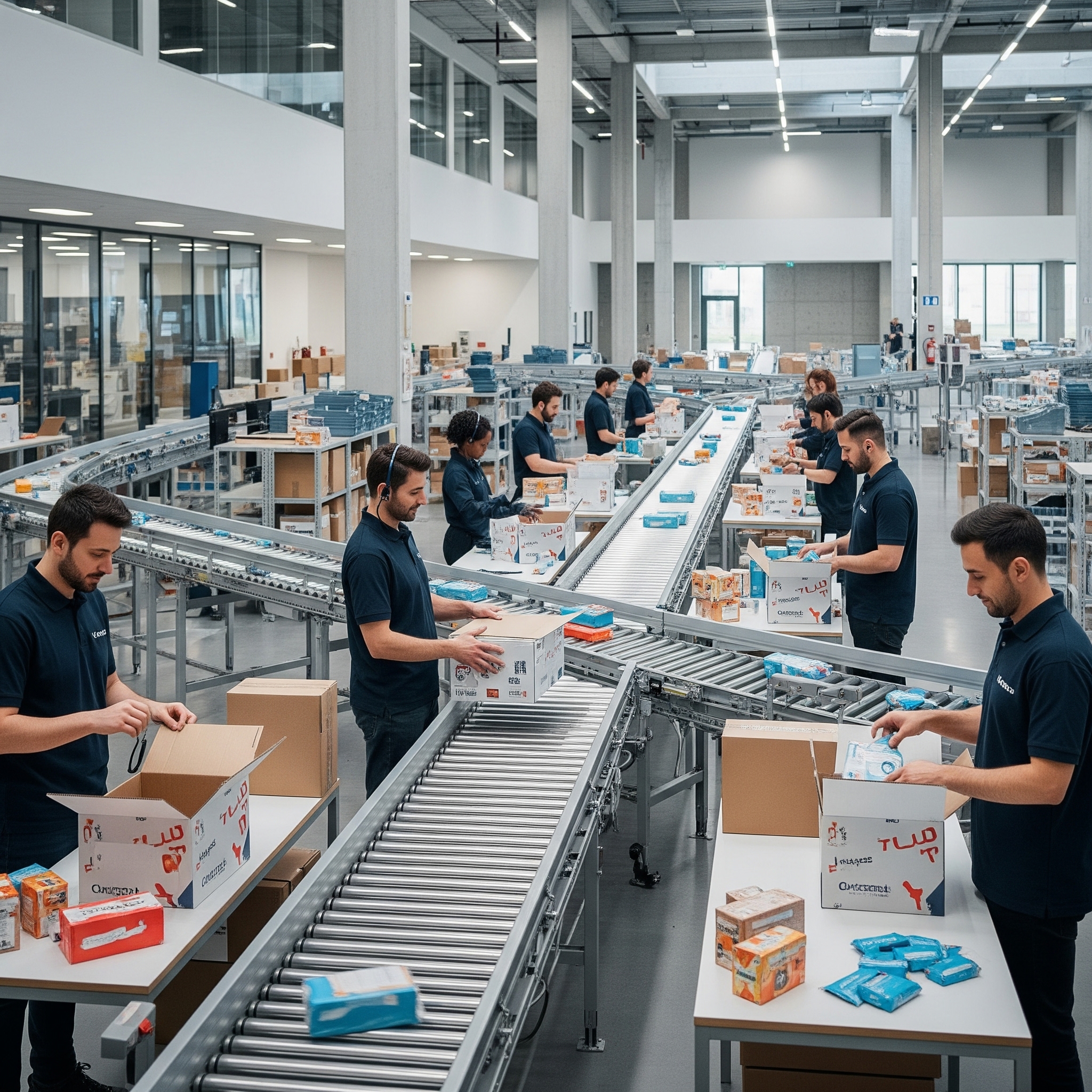
Blogs
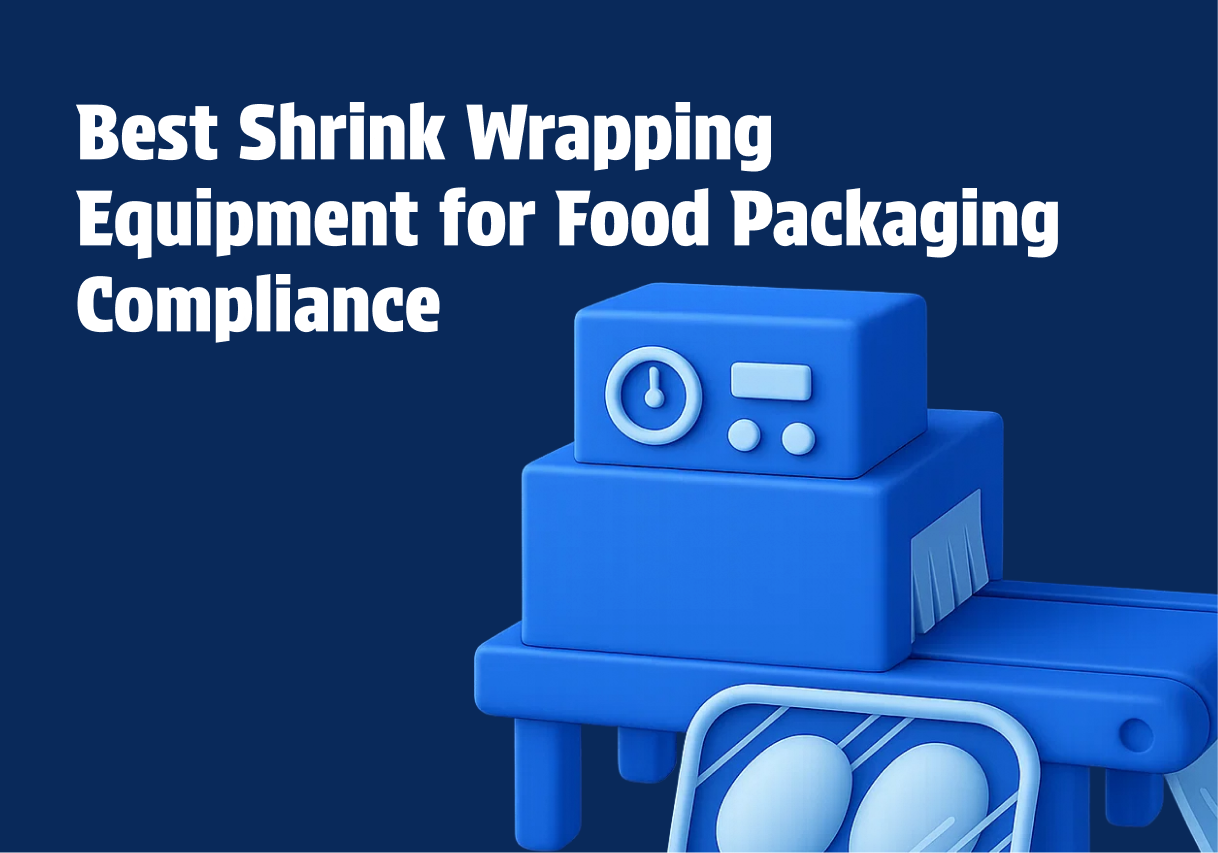
Best Shrink Wrap Machines for Your Business
Discover the best shrink wrapping equipment for food packaging compliance. Conflex offers high automation. Increase efficiency now!
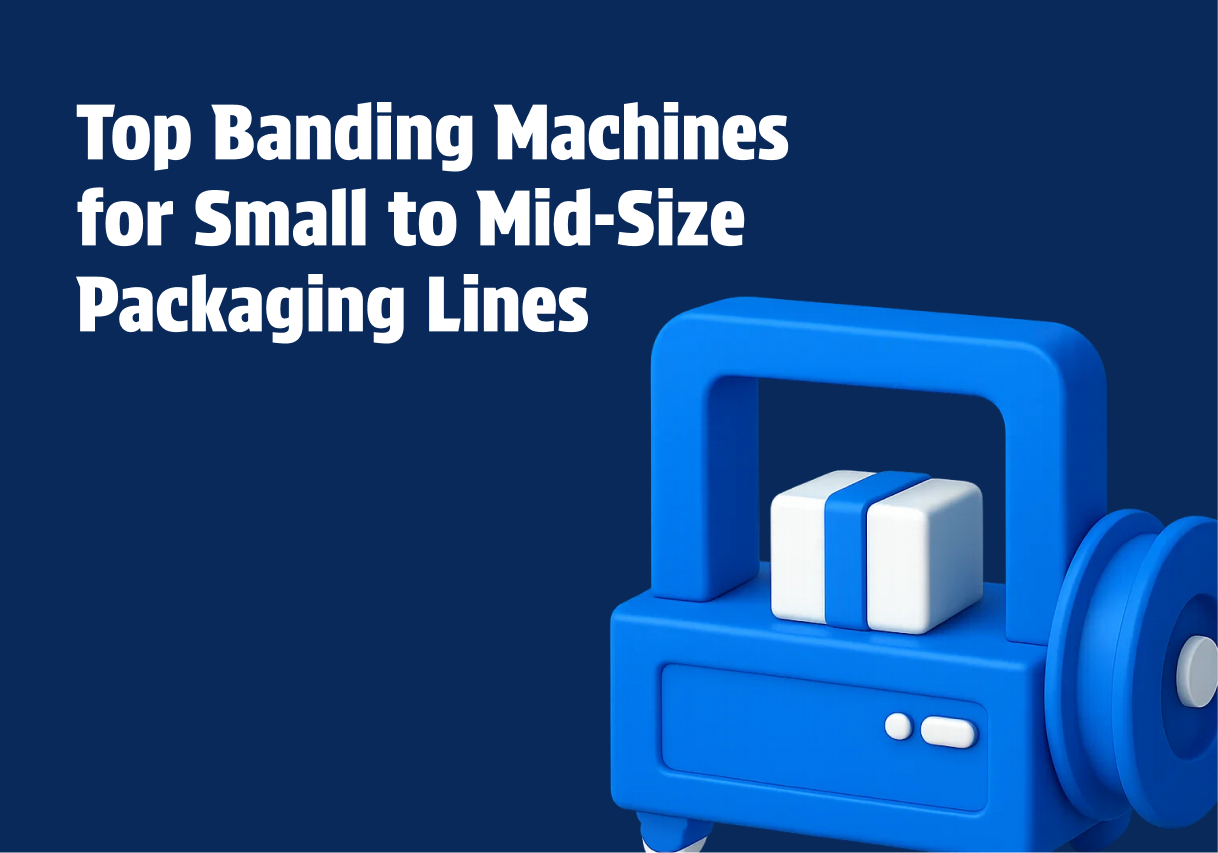
Top Banding Machines for Packaging Solutions
Find top banding machines for small to mid-size packaging lines! Discover flexible automation options and sustainability features. Optimize efficiency today!
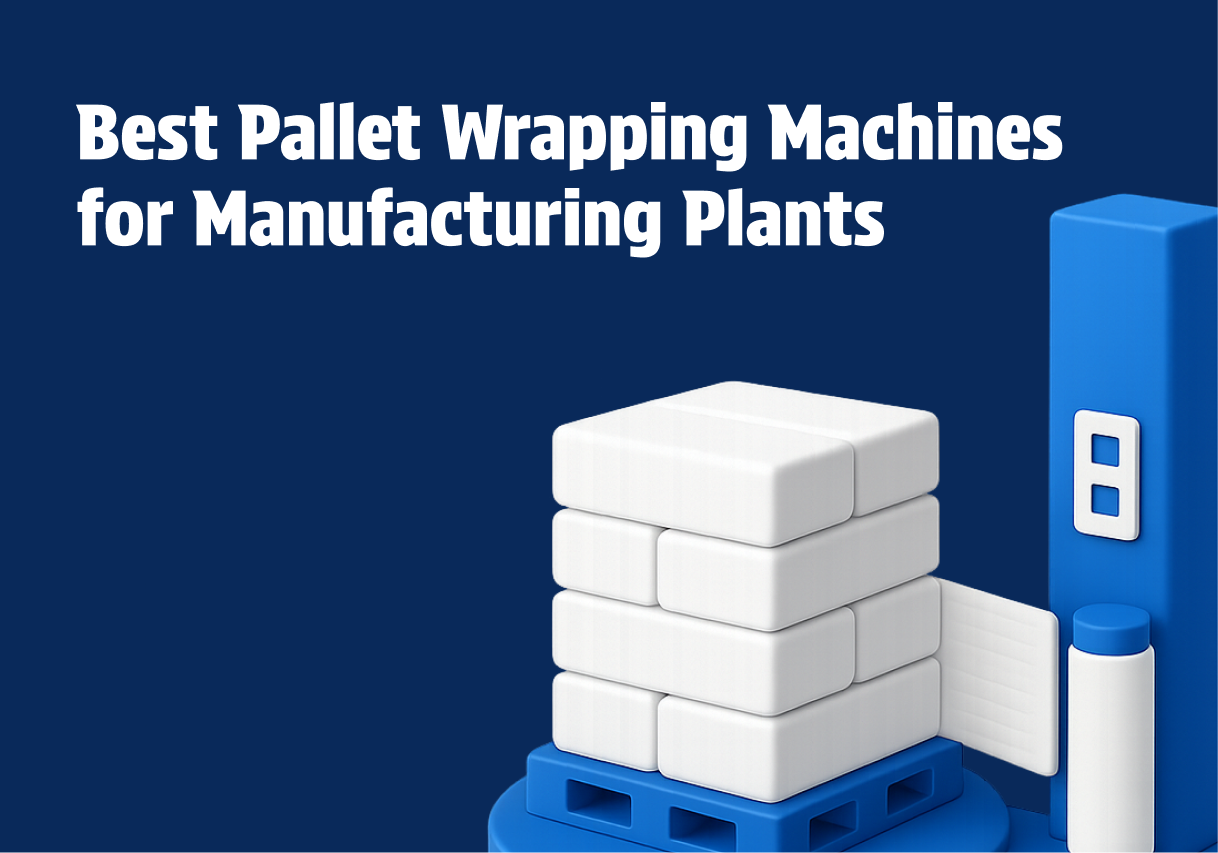
Best Pallet Wrapping Machines for Manufacturing Plants 2025
Explore the best pallet wrapping machines for manufacturing plants in 2025. Learn how to choose, compare key models, and reduce wrapping costs.